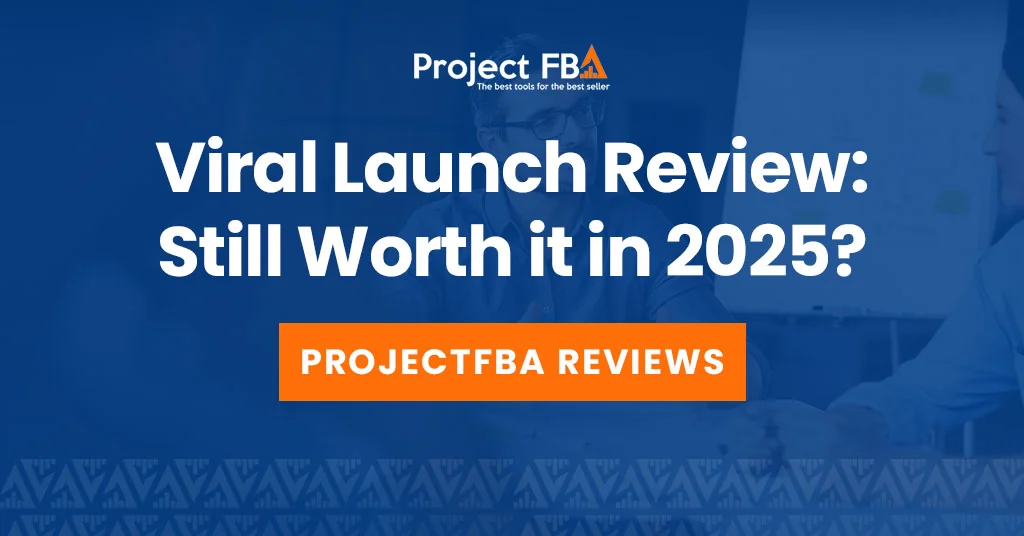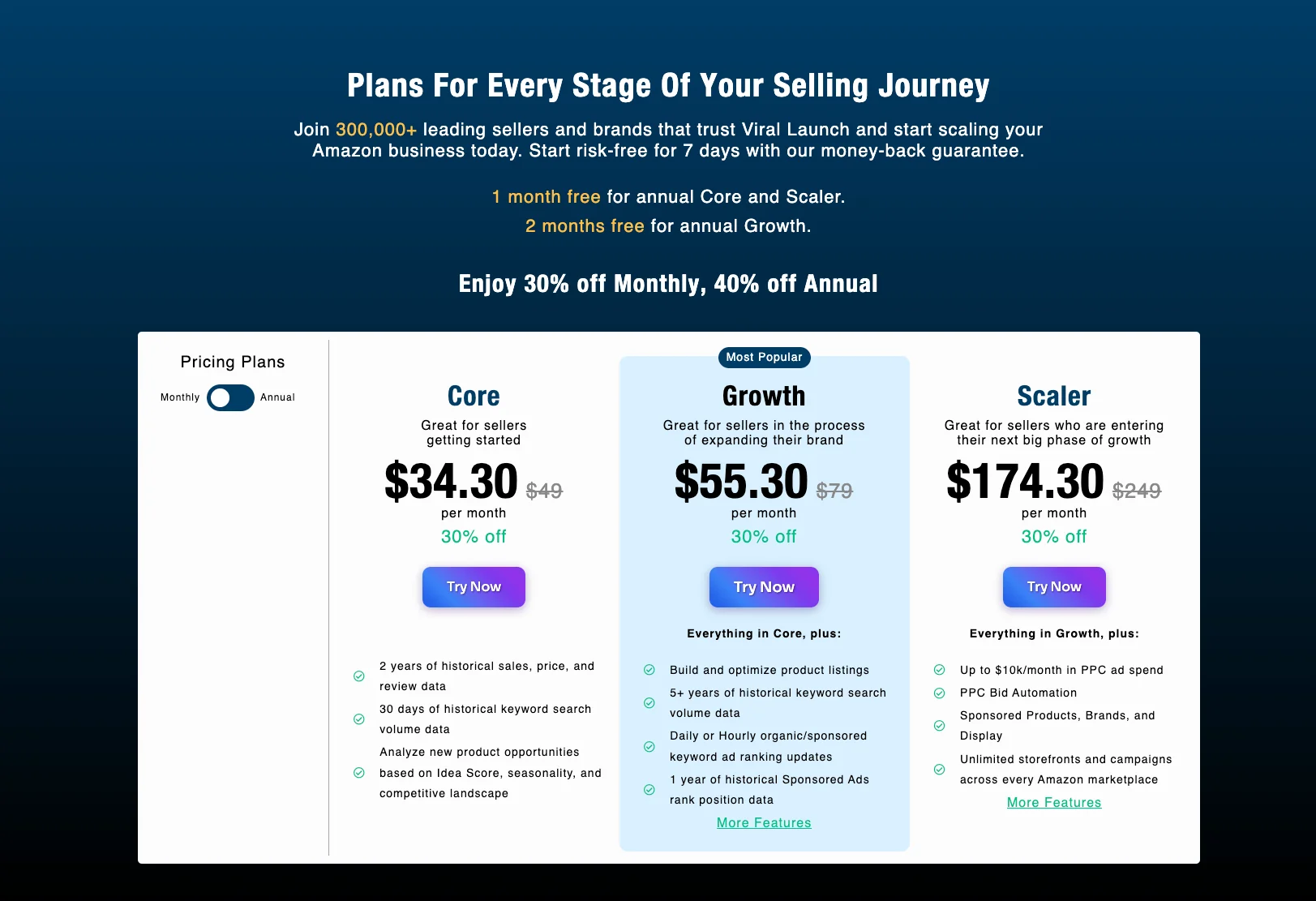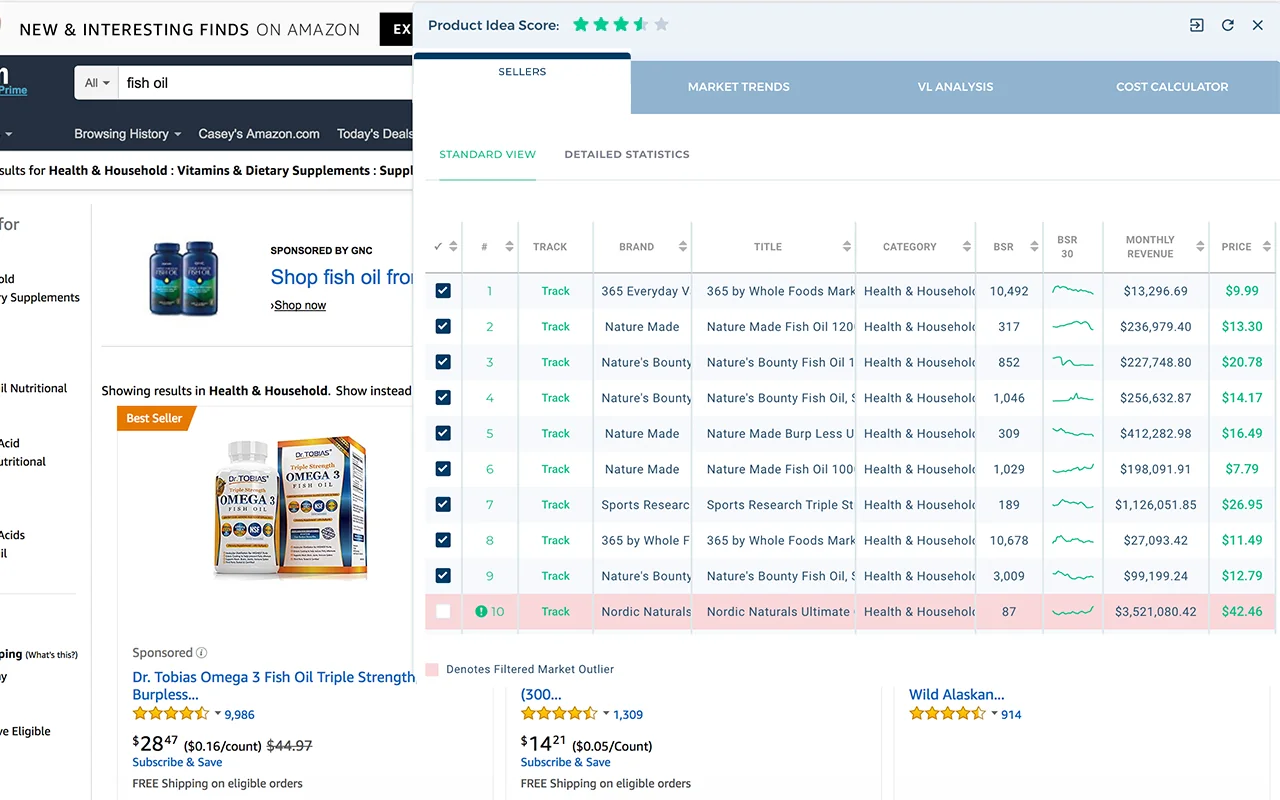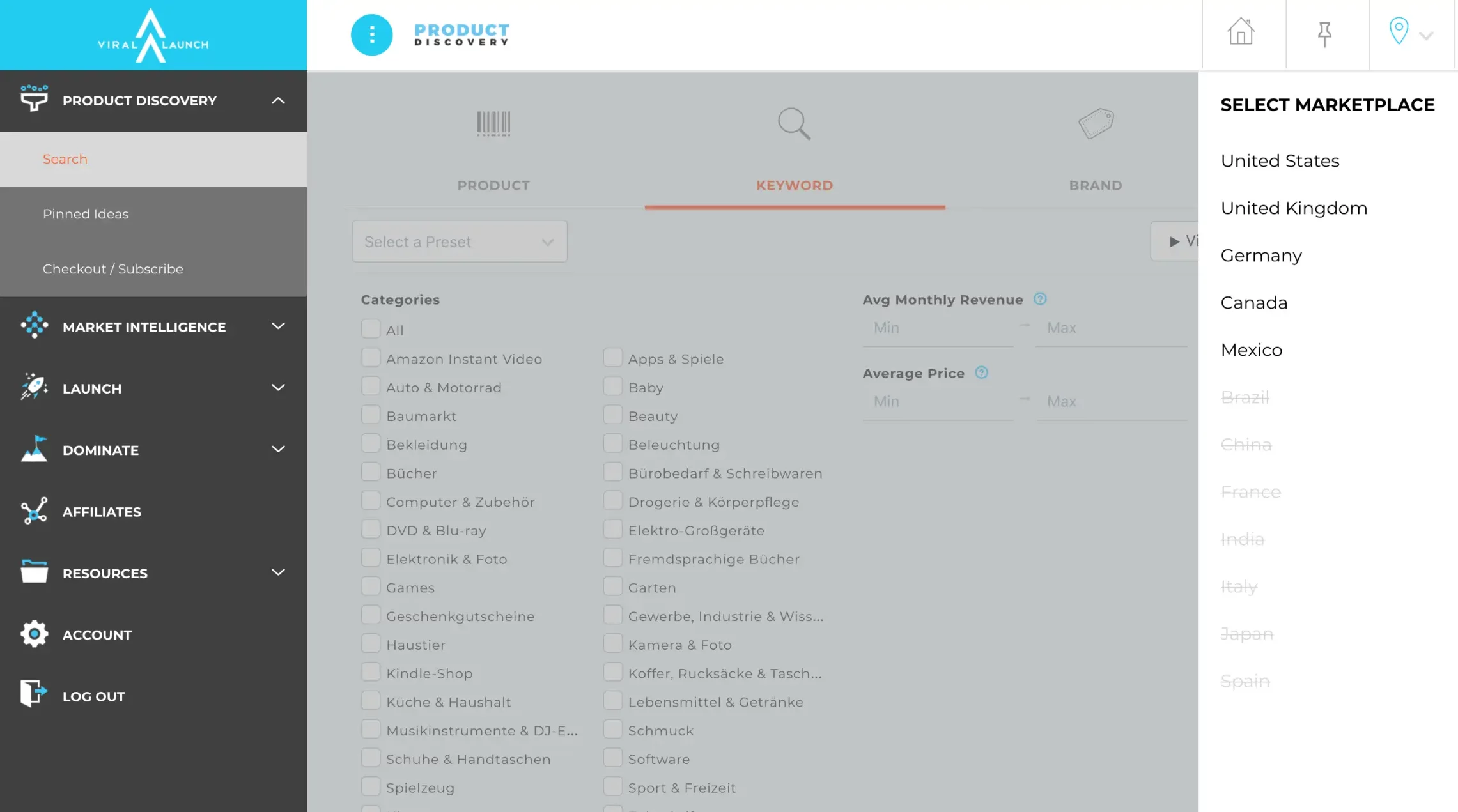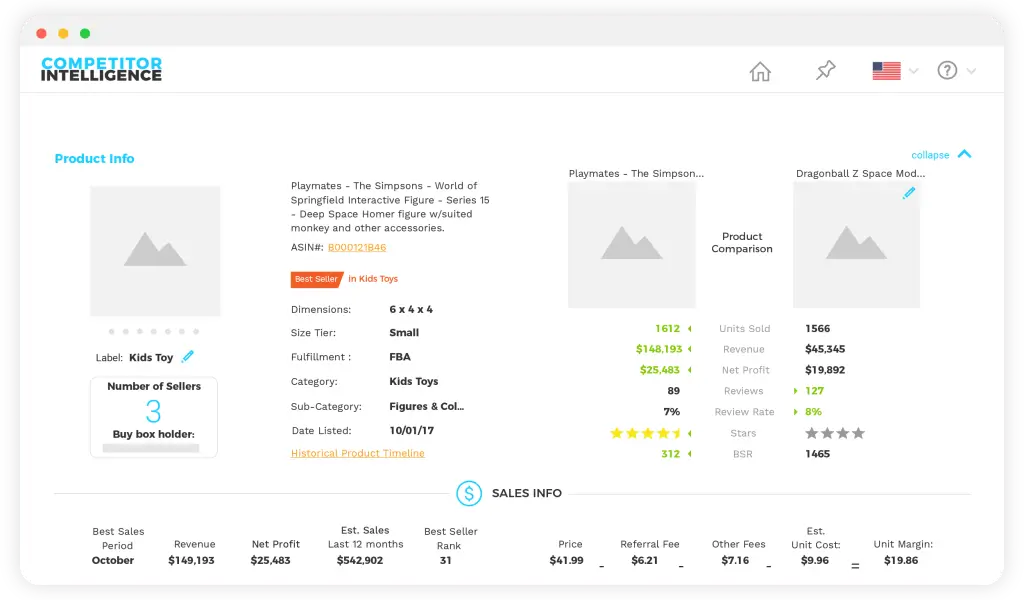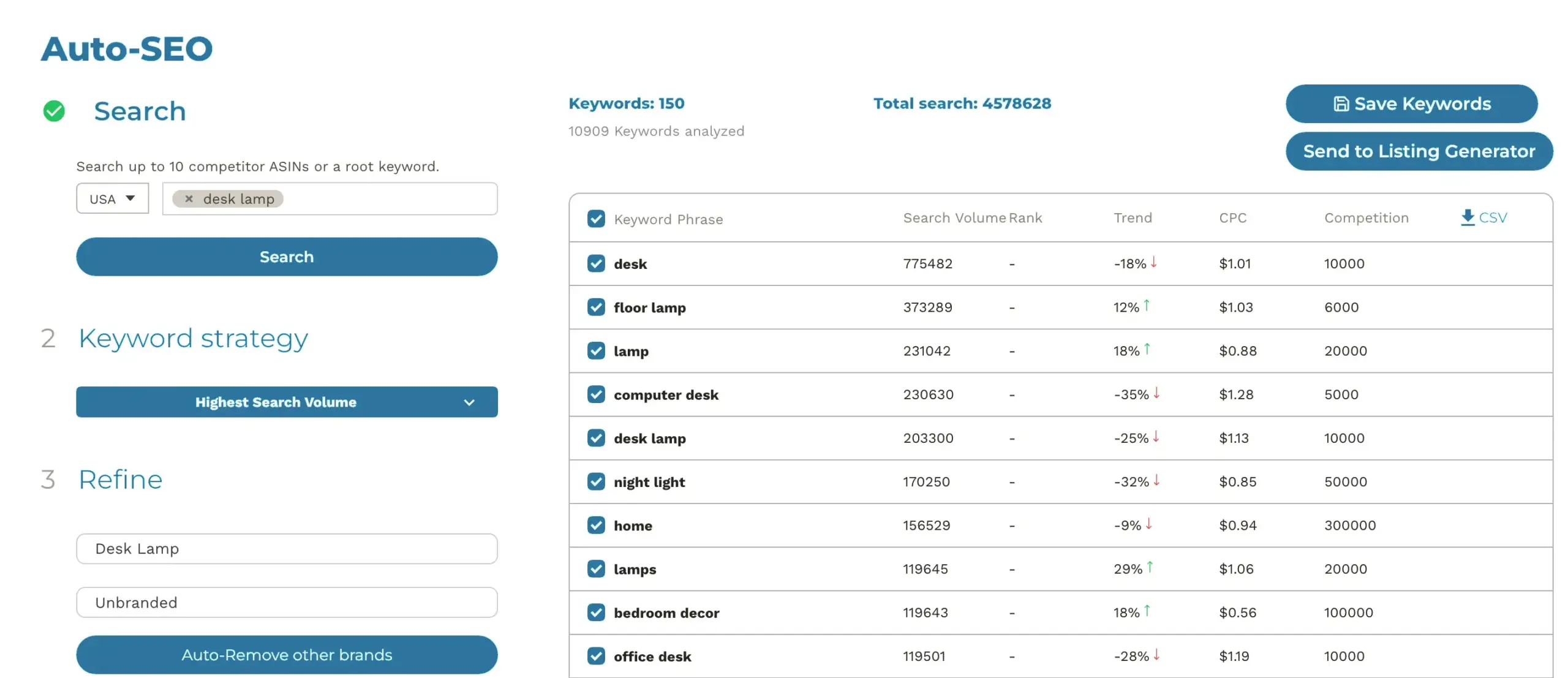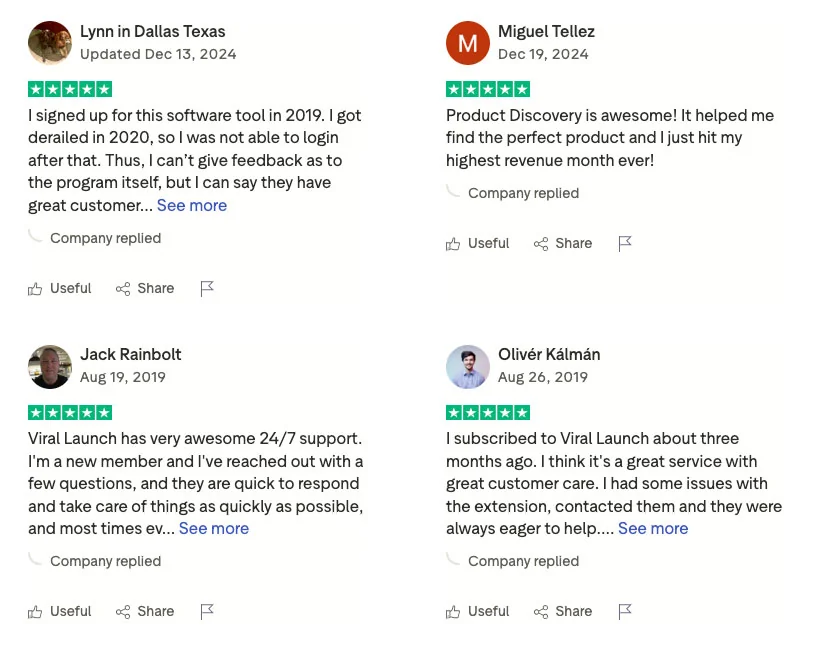What is Viral Launch?
Viral Launch is an all-in-one software and services platform built to help Amazon sellers research, launch, and grow their businesses. It combines data-driven tools with guided workflows to identify profitable products, optimize listings, and manage PPC campaigns for greater visibility and sales.
Viral Launch is best known for helping new and growing sellers gain traction quickly, thanks to strong launch services and PPC capabilities, while still offering a full suite of research and listing tools. If your priority is kickstarting rankings and ads for a new product, it’s a compelling choice. If you need an all-purpose toolkit for every corner of your Amazon operation, compare it side by side with Helium 10 to see which aligns better with your workflow.
What Viral Launch does well
Guides new sellers: Step-by-step tools and education help beginners find viable products and navigate Amazon’s learning curve.
Boosts product visibility: Keyword insights and listing optimization tools help products rank higher and attract more organic traffic.
Increases sales and profit: Smarter product selection, conversion-focused listings, and automated PPC drive more sales and improve ROI.
Scales business growth: Automation and actionable dashboards streamline repetitive tasks so teams can grow efficiently over time.
Viral Launch Exclusive Discount and Coupon Code
Our updated list of Viral Launch discounts and promo codes now offers up to 40% off. No need to copy and paste the Viral Launch coupon code — just click my link for a discount code while the offer lasts. Plus, Viral Launch offers a 7-day money back guarantee.

UP TO 40% OFF
Use Viral Launch discount coupon: PROJECTFBA
Who is Viral Launch For?
Viral Launch is a versatile Amazon seller platform that can work for beginners, experienced sellers, and even larger brands. But it really shines in a few key areas, making it especially useful for certain types of sellers.
For Sellers Launching a New Product
Viral Launch built its reputation on product launches—and that’s still its strongest suit. It’s a great fit if you want to:
Generate a surge of initial sales to climb Amazon’s organic rankings.
Quickly collect those all-important first reviews to build trust and conversions.
Tap into a curated buyer network and coupon promotions to build momentum fast.
For Sellers Focused on Advertising and PPC
Its Ad Sprout (formerly Kinetic) PPC tool is a major draw for sellers aiming to maximize ad performance with less manual management. It’s best for those who want to:
Automate and optimize Amazon PPC campaigns to improve ROAS.
Use advanced automation rules to control bids and keywords.
Keep campaigns continually monitored and adjusted for peak efficiency.
For Sellers Who Rely on Data and Intelligence
Viral Launch appeals to sellers who like making data-backed decisions. It’s ideal if you want to:
Identify profitable products and niches with the discovery tool and Chrome extension.
Analyze competitors with reverse market lookups, keyword tracking, and performance monitoring.
Optimize listings with precision using the listing analyzer, keyword manager, and builder.
When Viral Launch May Not Be the Best Fit
While powerful, Viral Launch isn’t perfect for everyone. It may not be the right choice if you:
Are on a tight budget: Entry plans exist, but many essential features are locked in higher-tier pricing. Jungle Scout is often seen as more budget-friendly.
Need an all-in-one management suite: It lacks extras like inventory protection and refund reconciliation found in Helium 10.
Prefer simpler research tools: Some sellers find its product and keyword research less intuitive or more complex compared to competitors.
Conclusion
Viral Launch is a strong pick if you’re focused on launching products, automating PPC, or using data to outsmart competitors. But if you want a budget-friendly, all-purpose toolkit, you may want to compare it side-by-side with Helium 10 or Jungle Scout.
Viral Launch Pros and Cons
Best-in-class product launch service - Helps new products gain early sales velocity and lift organic rankings.
Powerful PPC automation - Ad Sprout (formerly Kinetic) PPC offers advanced, customizable rules that improve ad spend efficiency.
Strong data accuracy - Reliable market intelligence and a Chrome extension that surfaces clear, on-page insights.
Clean, user-friendly interface - Intuitive dashboard that suits both beginners and experienced sellers.
Effective competitor intelligence - Reverse market lookups, listing tracking, and keyword discovery reveal niche opportunities.
Comprehensive listing optimization suite - 3-in-1 keyword manager, listing builder, and analyzer to craft high-converting listings.
Excellent customer support - Users often report quick, helpful responses.
Missing some seller management tools - Lacks features like an inventory protector or refund management found in broader suites.
Viral Launch Pricing
Viral Launch currently offers three pricing plans—Core, Growth, and Scaler—each with a 7-day money back guarantee. Annual billing provides significant savings compared to monthly subscriptions. Make sure to use our Viral Launch discount code to receive up to 40% off!
Core
- Monthly: $49/month (using our discount – $34.30)
- Annual: $45/month (using our discount – $27)
- Best for: New sellers validating their first product idea.
- Key features:
- Product research with up to 2 years of historical data (sales, price, reviews).
- Idea Score to quickly evaluate product potential.
- Keyword data with 30 days of historical search volume.
Growth
- Monthly: $79/month (using our discount – $55.30)
- Annual: $66/month (using our discount – $39.60)
- Best for: Sellers scaling and optimizing listings.
- Key features:
- Advanced analytics with 5+ years of keyword history and hourly rank tracking.
- Listing Builder for creating high-converting product pages.
- Competitor tracking for up to 500 competitors and 2,000 keywords.
- Listing Analyzer with up to 50 queries per month.
Scaler
- Monthly: $249/month (using our discount – $174.30)
- Annual: $228/month (using our discount – $136.80)
- Best for: Established brands and heavy Amazon advertisers.
- Key features:
- Ad Sprout (formerly Kinetic) PPC Automation for up to $10,000 monthly ad spend.
- Unlimited market access across storefronts and Amazon marketplaces.
- Expanded usage limits for keywords, products, and competitor tracking.
| Plan | Monthly Price | Annual Price | Best For | Key Features |
|---|---|---|---|---|
| Core | $49 | $45/month ($539 billed annually) |
New sellers validating ideas |
|
| Growth | $79 | $66/month ($790 billed annually) |
Scaling sellers optimizing listings |
|
| Scaler | $249 | $228/month ($2,739 billed annually) |
Established brands & PPC-heavy sellers |
|
Viral Launch Feature Overview
Viral Launch is more than just a research tool—it’s a full suite that helps Amazon sellers through every stage of their journey, from finding profitable products to optimizing listings and scaling with advertising.
Product Research & Market Intelligence
Product Discovery (Finder): Advanced filters for sales, revenue, reviews, and price, plus an Idea Score and Brand Filtering for smarter product validation.
Market Intelligence (Chrome Extension): Highly accurate, real-time data on Amazon product pages—covering demand, competition, sales, and fulfillment type.
Keyword & SEO Optimization
Keyword Research: Identifies high-traffic keywords with Amazon-based data, including CPC bids and Relevancy/Opportunity Scores.
Competitor Intelligence (Reverse ASIN): Reveals competitor keywords and strategies with sales and revenue estimates.
Keyword Rank Tracking: Monitors organic and sponsored ranks over time.
Listing Optimization
Listing Builder: Guides keyword-rich listing creation.
Listing Analyzer: Provides a SWOT-style analysis of strengths and weaknesses for conversion improvement.
Split Testing (Listing Dojo): Lets sellers A/B test titles, images, and pricing to boost conversions.
Advertising & Launch Services
Product Launch Service: Viral Launch’s flagship feature—drives early sales velocity and reviews using promotions and discounts.
Ad Sprout (formerly Kinetic) PPC Automation: A rule-based platform that automates ad campaigns for smarter spend and higher ROI.
Other Tools
Product Photography: Professional, high-quality images tailored for Amazon.
Profitability Calculator: Helps assess margins and costs before investing.
| Category | Key Tools & Features |
|---|---|
| Product Research & Market Intelligence |
|
| Keyword & SEO Optimization |
|
| Listing Optimization |
|
| Advertising & Launch Services |
|
| Other Tools |
|
Viral Launch Market Intelligence (Chrome Extension)
The Viral Launch Market Intelligence Chrome Extension brings instant, on-page market data to Amazon search and product pages. It helps you validate ideas, gauge competition, and spot profitable niches without leaving Amazon.
How it works
Open an Amazon results page or product listing, then scan the extension’s tabs to get the story behind the market in seconds.
Sellers tab
Monthly revenue and sales – Estimated revenue and units sold for each top product.
Unit margin – Quick per-unit profit view after Amazon fees and core costs.
Brand and reviews – See which brands dominate, plus review counts and average ratings.
Keywords tab
Related keywords – Find adjacent terms with estimated search volume.
Competitor performance – See which keywords competitors rank for and uncover gaps you can target.
Trends tab
Historical sales and BSR – Visualize demand and competitiveness over time.
Price and reviews over time – Spot seasonality, price swings, and review velocity trends.
Analysis tab
Product Idea Score – A 1-to-5 star snapshot of market potential that factors in sales, required review depth, and volatility.
AI insights – Helpful tips, warnings, and alerts that flag saturation, odd sales spikes, or other red flags.
Calculator tab
FBA and FBM profitability – Estimate per-unit profit for both fulfillment paths.
Clear fee breakdown – See Amazon fees, shipping, and other costs for an accurate bottom line.
Why sellers like it
Saves time – Do research without hopping between tools and tabs.
Data you can trust – Estimates draw on years of real Amazon data plus machine-learning models.
Streamlined workflow – The most important metrics live in one place for faster decisions.
Fewer costly mistakes – AI warnings help you avoid oversaturated or misleading markets.
Pro tips
Start broad, then narrow – Begin on a keyword results page to size the niche, then dive into standout ASINs.
Cross-check profitability – Use the Calculator tab with your actual COGS and shipping so the margins are real, not theoretical.
Watch the trend lines – Consistent demand with stable pricing usually beats flashy short-term spikes.
Validate keywords early – Use the Keywords tab to plan your listing and PPC before you source.
Viral Launch Product Discovery
Product Discovery helps Amazon sellers surface profitable opportunities by scanning millions of listings and scoring what looks promising. Instead of guessing, you set your criteria and let the tool surface products, keywords, brands, or categories that match real demand with manageable competition.
Four ways to search
Product – Hunt for individual ASINs that fit your targets. See estimated monthly sales, price, BSR, and profit estimates at a glance.
Keyword – Start with a niche or search term to uncover markets, not just one-off products. Great for sizing demand before you source.
Brand – Analyze winning brands to spot repeatable plays and gaps you can fill.
Category – Drill into categories and subcategories to catch trends early.
Key features you’ll use a lot
Advanced filters – 100+ filters to dial in by sales, revenue, price, reviews, investment cost, historical patterns, and more.
Idea Score – A proprietary 1 to 5 star indicator of market potential based on demand, competition, and seasonality. Treat 5 stars as a starting point, not a finish line.
Pinned Ideas – Save, label, and come back to your short list without losing the thread.
One-click deep dives – Jump straight into Market Intelligence for trend graphs, competitive context, and pricing history on any promising find.
Presets for beginners – Quick-start recipes like Low entry barriers and High margin markets help you find viable micro-niches without tweaking every filter.
Global reach – Search across international Amazon marketplaces to expand beyond your home market.
Quick start recipe
Choose Keyword or Category mode to size the market first.
Apply a beginner-friendly filter set:
Price: 20 to 60
Estimated monthly sales: 300 to 1,500
Reviews: under 300
Net margin: at least 25 percent
Seasonality: low to moderate
Sort by Idea Score, pin 5 to 10 candidates, then open each in Market Intelligence to check trend lines, price stability, and review velocity.
Run the profitability calculator with your real COGS and shipping to confirm margins.
Validate differentiation options before you ever request samples.
Smart filter ideas
Inventory light – Prioritize small, under 2 lb items to simplify logistics.
PPC friendly – Favor keywords with healthy volume and moderate competition to keep CPCs in check post-launch.
Defensible angle – Look for listings with weak images, thin copy, or poor review moats so you can win on execution.
Best practices
Chase patterns, not spikes – Stable demand with steady pricing beats one-month wonders.
Triangulate – Use Product Discovery to find, Market Intelligence to verify, and the calculator to sanity-check profit.
Don’t over-index on stars – Idea Score is a filter. Final decisions should include supplier quotes, differentiation, and PPC tests.
Pin ruthlessly – Keep a rolling short list and archive anything that fails the deep-dive.
Who It’s for
Beginners – Guided presets and scores make the first product search less overwhelming.
Experienced sellers – Rapidly add product lines, test new categories, or find underserved sub-niches.
Private label teams – Spot demand, confirm competition, and plan a defensible angle before committing capital.
Viral Launch Competitor Intelligence
Competitor Intelligence (aka Reverse Market Lookup) lets you reverse-engineer what drives traffic and sales for top competitors. Instead of guessing, you see the keywords, rankings, and ad plays that power their growth so you can spot gaps, outmaneuver their strategy, and prioritize high-ROI terms.
How it works
ASIN-based analysis – Paste in 1-10 competitor ASINs to get a holistic keyword view of the niche, not just a single product.
Keyword discovery – Uncovers both organic and sponsored keywords your competitors rank for or bid on.
Competitive context – For each keyword, you’ll see the metrics that matter for prioritization and profit.
What you’ll see
Keyword list – Comprehensive exportable list tied to your entered ASINs.
Search volume – Estimated monthly searches to gauge traffic potential.
Rank position – Current organic rank per ASIN (1, 5, 20, etc.).
Relevancy score – How closely the keyword matches the product and shopper intent.
Opportunity score – High-volume terms with lower relative competition surface to the top.
Sales estimates by keyword – Connects likely traffic to revenue impact.
Sponsored data – Which keywords competitors bid on and estimated CPC ranges to frame PPC costs.
Historical performance – Trend lines for ranking and demand to catch seasonality and momentum.
Filters and export – Slice by volume, rank, relevance, opportunity, CPC, and more, then export to CSV for deeper analysis.
Practical workflows
1) Keyword research you can ship
Enter 3-5 top competitor ASINs.
Filter to relevancy 80 percent+, volume 500-10,000, exclude branded terms.
Sort by opportunity score, then sanity-check CPC against your target ACoS.
Export your short list to build an initial SEO and PPC plan.
2) Listing optimization with intent
Map head terms to title and H1-level phrases.
Use mid-volume, high-relevance terms in bullets and description.
Capture long-tail conversions in backend keywords.
Recheck rank movement weekly and iterate.
3) PPC that mirrors winning plays
Harvest competitors’ sponsored keywords, grouped by intent:
Buyer intent: “best X”, “X for Y”, “X size/color”.
Feature intent: material, capacity, compatibility.
Problem intent: “leakproof”, “noise reducing”, “pet safe”.
Start with exact and phrase on high-relevance terms, add broad with tight negatives.
Use CPC and margin guardrails to keep TACOS in range.
4) Find market gaps
Filter for high opportunity, high relevancy, mid competition.
Flag terms where competitors rank 15-40 with thin content or weak images.
Plan differentiation angles to win the SERP: bundles, variants, upgraded materials, better visuals.
Smart settings to try
Volume 800-6,000, relevancy 85 percent+, opportunity score high, CPC under your breakeven click price.
Include multi-word phrases (2-4 words) first to control CPC, then scale to head terms once conversions prove out.
Track 25-50 core keywords in your rank tracker to confirm your changes move the needle.
Best practices
Triangulate – Use Competitor Intelligence to find, Rank Tracking to validate gains, and the Search Term Report to confirm conversions.
Don’t chase spikes – Prioritize steady terms with consistent rank history over short-lived trends.
Guardrails matter – Set max CPC based on margin and target ACoS, not on what competitors are bidding.
Refresh often – Competitive keyword portfolios shift. Re-run your ASIN set monthly and before big promos.
Who It’s For
Beginners – Fast path to a vetted keyword set you can implement today.
Growth-stage sellers – Expand into adjacent terms and protect share against new entrants.
Private label teams – Build a defensible keyword moat with data-backed SEO and PPC.
Viral Launch Keyword and Listing Optimization
Viral Launch brings your keyword workflow and listing copy under one roof, so you can find the right terms, track what matters, and publish fully optimized listings that rank and convert.
Keyword research tools
Keyword Research
Enter a primary keyword and get a ranked list of related terms with the metrics you need to prioritize.
Priority Score – Weighs relevancy and volume to spotlight must-have terms.
Relevancy Score – How closely a term matches your seed keyword and shopper intent.
Opportunity Score – Finds lower-competition terms with strong upside.
Extras – Historical trend context and suggested CPC to frame SEO and PPC decisions.
Keyword Manager
Your control center for tracking and actioning keywords.
What it tracks – Organic rank, sponsored rank, and indexation status over time.
What it does – Surfaces rank changes, highlights wins and losses, and suggests bid tweaks.
Seamless handoff – Push terms from Keyword Research or Listing Analyzer straight into tracking.
Listing optimization tools
Listing Builder
Write keyword-rich titles, bullets, and descriptions with live feedback.
Keyword integration – Pulls in your target terms from Keyword Research or Keyword Manager.
Optimization Score – Real-time grading of usage and placement as you write.
Import existing ASINs – Audit current listings to find missing high-volume terms.
Backend search terms – Auto-collect unused but relevant keywords for backend fields.
Listing Analyzer
Grade existing listings and see how you stack up.
Competitive lens – Benchmarks against top competitors on price, reviews, and sales.
Content quality – Checks keyword saturation, image specs, and character limits.
Clear fixes – Actionable recommendations to improve visibility and conversion.
LaunchGPT
AI that drafts Amazon-ready copy you can ship fast.
What it creates – Titles, bullets, and descriptions aligned to your target keywords.
Why it helps – Speeds up first drafts, supports multilingual expansion, and follows Amazon formatting guidelines.
How it all fits together
Start in Keyword Research to build a prioritized term set.
Send selected keywords to Keyword Manager for tracking and index checks.
Open Listing Builder and write your copy until the Optimization Score is green.
If optimizing an existing ASIN, run Listing Analyzer first, then update with Listing Builder.
Use LaunchGPT for fast drafts, then refine with your brand voice and target keywords.
Monitor ranks and indexation in Keyword Manager and iterate.
Quick start checklist
Build a 3-tier keyword list: core head terms, high-relevance mid-tail, and long-tail converters.
Place primary terms in title, secondary in bullets, supporting in description and backend.
Keep titles readable – avoid keyword stuffing that hurts CTR.
Track 25-50 priority terms in Keyword Manager post-publish.
Recheck indexation and organic rank weekly for the first 4 weeks.
Pro tips
Let Opportunity Score guide early wins, then expand into higher-CPC head terms once conversion is proven.
Use Listing Analyzer before big promos to fix easy visibility blockers.
Keep a living keyword set – add rising long-tail terms from PPC search term reports.
Viral Launch – Launch and Advertising Tools
Viral Launch still shines where it started: kickstarting sales velocity and turning data into smarter ads. Today it bundles launch support, advanced PPC automation, and listing split tests so you can earn visibility faster and grow efficiently.
Product Launch Service
Jumpstart rank by concentrating real demand in a short window.
How it works
Run a targeted promotion to a curated shopper audience using compliant discounts and traffic sources.
Concentrated sales velocity helps Amazon’s search ranking system recognize your product’s relevance for target keywords.
Why it helps
Faster momentum – Early sales clusters accelerate organic visibility.
More discoverability – Higher positions drive more clicks and sessions, compounding over time.
Good to know
Follow Amazon’s policies: do not request incentivized reviews, do not condition discounts on reviews, and avoid tactics that manipulate rank. Treat any reviews that appear as organic, optional outcomes from normal purchasing behavior.
Launch checklist
Inventory buffer: 2-4 weeks of expected post-promo demand.
Target set: 10-30 keywords with mix of head and mid-tail terms.
Offer structure: compelling but sustainable discount, coupon set-up, and tracking links.
PPC ready: campaigns prebuilt to capture post-promo traffic.
Ad Sprout (formerly Kinetic) PPC automation
Rule-based Amazon PPC that reacts in real time so you do not have to.
How it works
Create rules that adjust bids, budgets, and keywords based on performance thresholds.
Use templates for common goals, then fine-tune at campaign, ad group, or keyword level.
Key features
Automation rules – Examples:
Scale winners: if ACoS < target and conversions ≥ X, increase bid Y percent.
Cut waste: if spend ≥ 2x CPA target with 0 sales, pause or add negative.
Rank push: for top 5 keywords, boost bids until position threshold is met within max CPC guardrail.
Analytics dashboard – ROAS, ACoS, conversions, CPC, CVR, and placement data with product-level rollups.
Product-level insights – See which SKUs actually earn the click and conversion in each campaign.
Smart starting points
Targets: set ACoS by margin and TACOS by portfolio goal.
Guardrails: max CPC = breakeven click price; cap daily budgets during testing.
Structure: exact and phrase for core terms, broad for discovery with tight negatives.
Listing Dojo (split testing)
Data-driven CRO for your listing elements.
How it works
Rotate variants of titles, main images, bullets, descriptions, or price.
Compare click-through and conversion to identify the winning version.
Benefits
Higher conversions – Optimize the two biggest levers first: main image and price.
Data-backed decisions – Replace hunches with measured lifts.
Profit focus – Test price bands to balance volume and margin.
Testing tips
One variable at a time. Start with main image, then title, then price.
Run long enough to reach stable results. Aim for at least several hundred sessions per variant.
Avoid seasonality bias. Pause tests during major promos unless that is the scenario you want to optimize for.
How it all fits together
Launch: run a short, compliant promo to spark sales.
Capture: turn on Ad Sprout PPC with rank-push rules for your top keywords.
Convert: run Listing Dojo tests on main image and title to lift CTR and CVR.
Scale: let automation expand winning keywords and trim waste while you add new terms and variants.
Pro tips
Momentum over spikes – Consistent, defensible rank beats one-day surges.
Budget with TACOS in mind – Tie PPC spend to total revenue, not just ad-attributed sales.
Refresh rules monthly – Markets shift. Revisit targets before big retail events.
Document wins – Save rule sets and test learnings as reusable playbooks for the next launch.
Viral Launch Support and Training
Viral Launch backs its tools with responsive support and plenty of education for every stage of your Amazon journey.
Customer support
Email support – Reach the Customer Success team at service@viral-launch.com.
Live chat – Connect with support from the chat box on the site. Many users report quick, helpful responses.
7-day money-back guarantee – Try the tools risk-free for a week.
Social channels – Stay current and ask quick questions via Facebook, Twitter, and LinkedIn.
Training and educational resources
Knowledge Base – A searchable Help Center with step-by-step guides on everything from Ad Sprout PPC to the Market Intelligence Chrome extension, plus general Amazon selling tips.
Blog – Regular articles on ecommerce advertising, listing optimization, product research, and broader Amazon strategy.
Video tutorials – Walkthroughs and how-tos on YouTube for Product Discovery, launch workflows, and more.
Checklists and guides – Downloadable resources to streamline tasks like listing optimization and launch prep.
Free courses – Partner-led classes for new sellers covering product selection, sourcing, and brand launches.
Follow the Data podcast – Practical discussions on Amazon strategy and best practices from the Viral Launch team.
How to get help fast
Check the Knowledge Base for a quick fix.
If you need a person, open live chat and include ASINs, screenshots, and your goal.
For deeper issues, email support with steps to reproduce and any recent changes you made.
Save time later by bookmarking the most-used guides for your team.
Pro tips for smoother support
Be specific – Include your marketplace, SKU or ASIN, and the exact tool view you’re using.
Share context – Mention campaign targets, ACoS or TACOS goals, and recent edits.
Keep a log – Track what changed and when to speed up troubleshooting.
Viral Launch Customer Reviews
Most reviews highlight strong launch results and an easy interface, while some sellers wish lower tiers included more features at a sharper price compared to competitors like Helium 10.
What people like
Product launch effectiveness – Many sellers report fast sales velocity, improved organic rank, and early review traction.
Powerful PPC automation – Ad Sprout (formerly Kinetic) PPC earns praise for rule-based automation that lifts ROAS and cuts manual work.
Trustworthy data – Users generally find sales estimates and market insights reliable for picking products and shaping strategy.
Intuitive UX – A clean, well-organized dashboard helps beginners and pros find what they need quickly.
Helpful support – Live chat and email support often get positive notes for responsiveness and clarity.
Where reviewers want more
Price and plan limits – Lower-tier plans can feel light on essentials like listing optimization or competitor tracking, pushing some users to upgrade.
Feature depth vs competitors – Launch and PPC are standouts, but product and keyword research tools are sometimes viewed as less extensive than Helium 10.
Missing management tools – No built-in reimbursement system or inventory protector, which some all-in-one suites include.
Who it fits best, according to reviews
New sellers – A friendly starting point to find the first product and launch it well.
Launch-focused teams – Ideal if you frequently introduce new SKUs and need rapid sales velocity.
Ad-driven sellers – Strong fit if you rely on Amazon ads and want customizable PPC automation.
Larger brands – Scaler plan aligns with bigger catalogs and higher ad budgets.
Conclusion: Is Viral Launch Worth It In 2025?
Short answer: yes if your strategy leans on fast, effective launches and strong PPC automation. Viral Launch shines at kickstarting sales velocity, automating ad performance, and keeping research streamlined. If you want a single platform that excels at launch and ads, it’s a smart pick.
When Viral Launch is worth it
Powerful product launches – The launch service helps create early sales velocity that supports higher organic rank and compounding traffic.
Advanced PPC automation – Ad Sprout PPC’s rule-based controls and clear analytics make scaling ads easier while protecting ROAS.
Strong market research – Product Discovery and the Market Intelligence Chrome extension are praised for accurate, granular niche insights, including helpful brand filtering.
Smooth user experience – A clean, intuitive dashboard reduces the learning curve and keeps workflows focused.
When to consider pairing with other tools
If you need a comprehensive all-in-one ops suite – Features like reimbursements or inventory protection are outside Viral Launch’s scope.
If you are tightly budgeted and need deep features at entry tiers – Some advanced capabilities live on higher plans.
If you want the deepest keyword research library – Viral Launch’s keyword tools are solid, but some reviewers prefer the breadth of Helium 10.
If you want extensive training programs – Viral Launch offers helpful education, but alternatives may include larger course ecosystems.
Verdict for 2025
Best for launches and PPC – New sellers aiming to “break the ice” fast and experienced teams scaling ads will get the most value.
Compare for all-in-one value – If you need broader day-to-day operations or the deepest keyword suite, evaluate competitors like Helium 10 or Jungle Scout alongside Viral Launch.
Try it safely
Use the 7-day money-back guarantee to run a focused evaluation:
Validate a niche in Market Intelligence,
Draft a listing in Listing Builder,
Launch with a targeted promo,
Turn on Ad Sprout PPC rules to capture momentum.
Conclusion
If launch speed and PPC efficiency are your priorities, Viral Launch is absolutely worth it.
How to Claim and Activate Viral Launch Discount and Coupon Code
- Click here (or any of our discount links) to redirect to a special Viral Launch pricing page where your discount is already applied.
- Select the plan that you want to purchase.
- Click the button to purchase your selected plan. This will take you to the checkout page.
- Your coupon code should already be applied and reflected on the total amount. (double check before completing the next step)
- If the coupon was not applied automatically enter “PROJECTFBA” in the coupon field.
- Complete the sign-up process by entering your details and providing payment information.

UP TO 40% OFF
Use Viral Launch discount coupon: PROJECTFBA
Viral Launch FAQ
Viral Launch, in a nutshell
What it is: Software + services to help Amazon sellers research, launch, and grow – from beginners to established brands.
Key tools:
Product Discovery – find high-demand, low-competition ideas
Market Intelligence (Chrome) – on-page sales, revenue, pricing trends
Keyword Research + Manager – discover and track keywords
Listing Builder + Analyzer – create and audit optimized listings
Launch services – generate early sales velocity for new products
Ad Sprout PPC – automate ads to improve ROAS
Why it helps:
Reduces guesswork with data-backed insights
Improves rankings through smarter SEO and listings
Saves time via automation (especially PPC)
Scales growth with analytics and competitor tracking
How to contact Viral Launch support
- Email support
- General or billing: service@viral-launch.com
- Product and account support: support@viral-launch.com
- Live chat
Open the chat widget at the bottom-right of any page on the Viral Launch site. - Help Center
Search step-by-step guides and FAQs in the online Help Center: https://help.viral-launch.com/en/. - Contact page
Prefer a form and quick links? Use the Contact Us page: https://viral-launch.com/contact-us/. - Refunds and terms
Viral Launch offers a 7-day money-back guarantee. See details here: https://viral-launch.com/terms-of-service/. For refunds, email support@viral-launch.com within 7 days.
Tip: When you reach out, include your marketplace, ASIN or SKU, screenshots, and your goal. It helps support get you answers faster.
No – Viral Launch is a paid, subscription-based platform. Every plan includes a 7-day money-back guarantee, so you can try it risk-free.
Ways to try it with no long-term commitment
7-day money-back guarantee – Cancel within 7 days for a full refund: see the Terms of Service.
Free tools – Use Viral Launch’s calculators without a subscription:
FBA Profit Calculator: https://viral-launch.com/amazon-fba-calculator/
Tariff Calculator: https://viral-launch.com/tariff-calculator/Market Intelligence Chrome extension – Free to install; requires an active Viral Launch plan to see data.
Web Store: https://chromewebstore.google.com/detail/viral-launch-market-intel/ncbhkghndhoddmbfgddpgafhbnijdadj
Details: https://viral-launch.com/blog/amazon-product-research/free-amazon-chrome-extension-for-fba-sellers/Free courses – Learn the basics and PPC strategy at no cost:
How to Sell on Amazon (Teachable): https://viral-launch.teachable.com/p/how-to-sell-on-amazon/
Amazon PPC Playbook (Teachable): https://viral-launch.teachable.com/p/amazon-ppc-101
Tip: Start with the calculators and a free course, then use the 7-day guarantee to test the full toolset (Market Intelligence, Keyword tools, Listing Builder, and Kinetic PPC).
The Product Idea Score is a proprietary 1-to-5 star rating that estimates a product’s market potential on Amazon. A 5-star score suggests a stronger opportunity; a 1-star score signals higher risk. You’ll see it inside Product Discovery and Market Intelligence to quickly triage ideas before you dive deeper.
What the score considers
Monthly sales – Estimated demand for the product.
Review count – How many reviews you’ll likely need to compete.
Sales patterns – Historical stability, volatility, and seasonality.
Pricing – Price history and consistency over time.
Amazon’s presence – How much you’re competing directly with Amazon.
How to use it in your workflow
Scan and sort – Filter for higher scores to surface candidates fast.
Shortlist – Pin 5-star and strong 4-star ideas that also meet your price, cost, and logistics criteria.
Validate – Open Market Intelligence to inspect trends, review velocity, and pricing history.
Sanity check profit – Run your real COGS, fees, and shipping to confirm margins.
Monitor – Revisit the score periodically to catch market shifts.
Important considerations
It’s a starting point, not a verdict – Use it to prioritize, then validate with deeper data and supplier quotes.
Costs matter – Factor in tariffs, packaging, prep, and PPC to avoid margin surprises.
Scores can differ by tool – Product Discovery may use cached data, while Market Intelligence reflects fresher inputs. Trust the fresher data for final validation.
Pro tips
Favor consistency – Stable demand and pricing usually beat short-term spikes.
Avoid heavy review moats – A high score plus low competing review counts is a strong sign.
Watch Amazon competition – If Amazon owns top spots, your differentiation bar is higher.
Pair with filters – Layer Idea Score with thresholds for price, reviews, weight, and size to match your capabilities.
Idea Score is your fast filter. Let it narrow the field, then confirm the winners with detailed market, cost, and differentiation analysis.
Why Idea Scores can differ
Viral Launch’s Product Idea Score may vary between Product Discovery and Market Intelligence because each tool uses different data sources and refresh rates.
Data sources and refresh rates
Product Discovery: Uses cached data refreshed about every 30 days. Great for fast filtering across millions of products and spotting broad trends.
Market Intelligence: Uses fresher, frequently updated data, including hourly BSR signals. Best for current, precise validation.
How to use them together
Find ideas in Product Discovery and sort by higher Idea Scores.
Pin a short list that also matches your price, cost, and review criteria.
Validate each pick in Market Intelligence to confirm demand, price stability, and competition right now.
Start wide with Product Discovery, make the call with Market Intelligence.
Viral Launch Product Discovery – simple how-to
Viral Launch Product Discovery finds profitable product ideas by scanning millions of listings and applying your filters. Use these four steps to keep it fast and focused.
1) Choose your search method
Product – Find individual product ideas that match your criteria.
Keyword – Surface niches and market themes, not just one product.
Brand – Study winning brands to spot gaps and patterns.
Category – Drill into categories and subcategories to catch trends.
2) Set your filters
Common filters
Monthly revenue/sales – Target the demand range you want.
Price – Match your budget and margin goals.
Review count – Lower reviews usually mean lower competition.
Categories – Limit results to the most relevant sections.
Advanced filters
Sales to reviews ratio – Higher ratio = stronger demand vs review moat.
Investment cost – Keep ideas within your startup budget.
Profit margin/average net profit – Align with your target margins.
Sales pattern – Pick seasonal, evergreen, or rising products.
Fulfillment – Filter by FBA, FBM, or Amazon.
3) Review results and pin winners
Sort results – Use Idea Score, sales, revenue, or reviews to prioritize.
Check Idea Score – 1 to 5 stars as a quick potential check.
Pin ideas – Save promising finds to your Pinned Ideas list.
Validate deeper – Open Market Intelligence from the result to confirm trends, pricing, and competition.
4) Refine and repeat
If nothing stands out, tweak filters or switch methods. Iterating uncovers micro-niches that fit your goals.
Quick starter filter idea: price 20-60, monthly sales 300-1,500, reviews under 300.
A browser extension that surfaces instant, on-page market data on Amazon search and product pages. It helps you validate ideas, analyze competitors, and spot profitable niches without leaving Amazon.
Core functions
Works on search or product pages – Switch between a broad niche view and a single ASIN view.
Five focused tabs
Sellers – Estimated monthly sales and revenue, profit per unit, FBA vs FBM mix, review counts.
Keywords – Related terms with estimated volume, plus competitor keyword positions.
Trends – Historical sales and BSR graphs, seasonality signals, pricing and review patterns.
Analysis – Product Idea Score (1-5 stars) and AI tips, warnings, and alerts.
Calculator – FBA/FBM profit estimates with a clear fee breakdown.
Key benefits
Time-saving – Make go/no-go calls right on Amazon, no tab hopping.
Data you can trust – Built on a large historical sales dataset.
Fewer mistakes – AI warnings flag oversaturation and unstable markets.
Included with subscription – Access is part of Viral Launch plans.
Quick tips
Start on a keyword results page to size the niche, then drill into standout ASINs.
Use the Calculator with your real COGS and shipping for accurate margins.
Treat the Idea Score as a fast filter, then confirm with Trends and Keywords before sourcing.
A promotional system that helps new Amazon products gain early sales velocity. This momentum can improve organic ranking and long-term visibility.
How it works
Submit your product
Provide the product URL, brand, and a short pitch.Purchase the launch
It is a one-time service, separate from subscription plans. Pricing varies by product and audience size.Set up the promotion
Launch duration: 1 to 15 days
Promotional units: how many discounted units you will offer
Discounted price: set a compelling deal
Keyword targets: choose terms you want to rank for
Coupons: single-use codes sent to an opt-in deal-seeking audience
Sales spike and ranking lift
A concentrated burst of sales can help your product surface higher for target keywords, which can lead to more organic traffic.Track results
View performance analytics to refine future launches.
Important notes
Reviews should be organic. Do not request or incentivize reviews in exchange for discounts.
Follow Amazon policies. Avoid tactics that manipulate rank or violate marketplace rules.
Ad Sprout PPC automates Amazon pay-per-click using customizable rules. It adjusts bids, budgets, and keywords so you can improve ROAS and scale with less manual work.
How it works
Connect your account – Link Seller Central and grant permissions.
See everything in one place – A clean dashboard for PPC sales, spend, ACoS, ROAS, conversion rate, and organic vs sponsored rank.
Set automation rules – Use templates or build your own if-then logic. Ad Sprout monitors performance and applies changes automatically.
Manage keywords smarter – Promote winners, add negatives, and pull suggestions from your Keyword Research to refine targeting.
Example rules
If ACoS > target for 3 days, decrease bid by 20 percent.
If conversions ≥ X and ACoS < target, raise bid by 10 percent.
If a search term spends 2x CPA with 0 sales, add as negative.
For top keywords, push rank while capping max CPC at your breakeven click price.
Why sellers use it
Time-saving – Fewer manual edits, more strategic work.
Maximized efficiency – Budget flows to the best campaigns and keywords.
Data-driven – Clear metrics guide every change.
Scalable – Rules handle growing catalogs and budgets without chaos.
Quick start
Connect Seller Central and confirm attribution.
Set targets: ACoS, TACOS, and max CPC guardrails.
Turn on a few templates, then add custom rules.
Review change logs and results weekly, tighten rules as you learn.
Short answer: For several features, yes. Tools that read your store data or make changes (like PPC automation) require permissions. Research tools do not.
Requires account access
PPC automation – Authorize Amazon Ads so automation can adjust bids, budgets, and keywords. (help.viral-launch.com)
Keyword Manager – Grant SP-API/Seller Central access to track ranks, indexation, and product data. (Viral Launch)
Listing Analyzer & Competitor Intelligence – Storefront access is needed for full analysis and monitoring. (Viral Launch)
Does not require access
Product Discovery and Market Intelligence (Chrome Extension) – Research tools that use Viral Launch’s market data, not your store connection.
How to grant access (quick)
Connect Seller Central via SP-API authorization.
Connect your Amazon Ads account.
Select only the permissions each tool needs.
Data and safety tips
Follow least-privilege: grant just what’s required.
Review connected apps and permissions periodically.
Connect your account for PPC, tracking, and listing analytics; skip it for pure research.
Yes, many beginners like Viral Launch for its easy interface and focused tools for research and launching. Value still depends on your needs and budget compared to other suites.
Why beginners like it
Structured research – Product Discovery and Market Intelligence guide you to viable ideas. Idea Score and presets keep it simple.
Starter-friendly plan – Core focuses on product research for the pre-selling stage.
Launch support – Built-in launch service helps new products gain early momentum.
Intuitive UX – Clean dashboard that’s easy to learn.
Helpful resources – Tutorials, blog, and a detailed Help Center.
Potential drawbacks
Advanced features cost more – Some listing and competitor tools sit on higher tiers.
Narrower toolkit – Fewer backend features than all-in-one rivals like inventory or reimbursement tools.
Training depth – Education is solid, but some competitors offer more comprehensive courses.
Verdict for beginners
Great if your first goals are finding a profitable product and launching it well. If you need a broader, all-in-one operations suite right away, compare entry-level plans across tools. Consider testing it with the 7-day money-back guarantee before committing.

